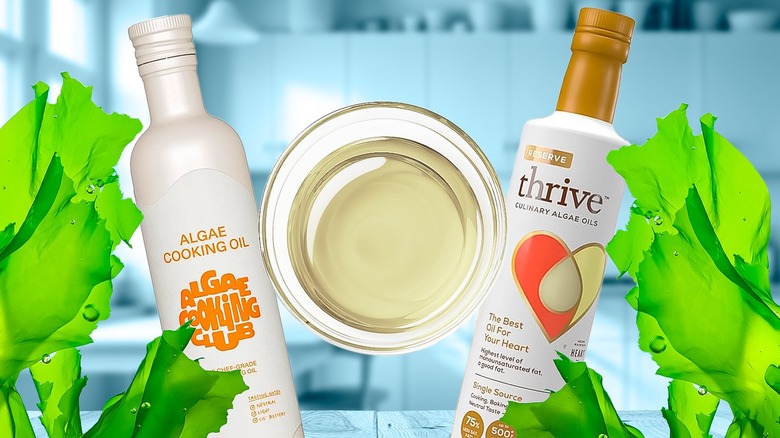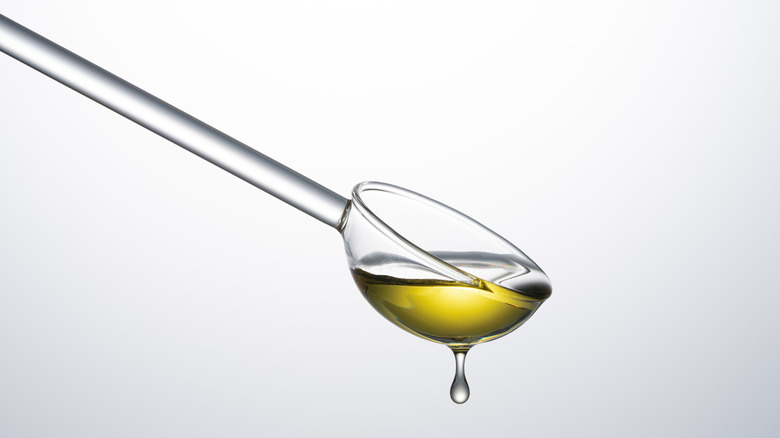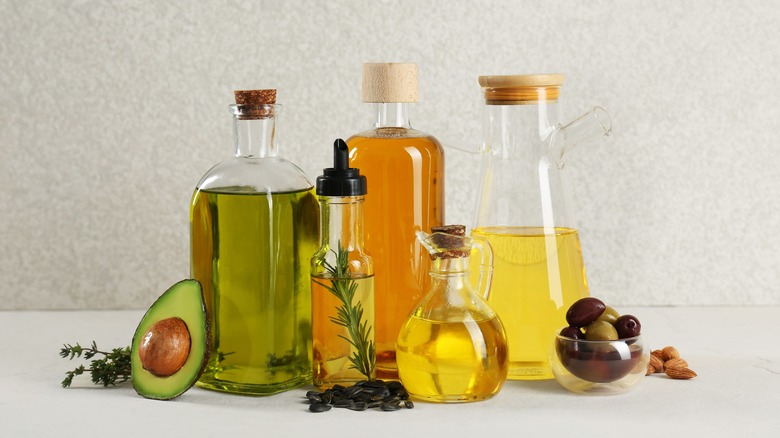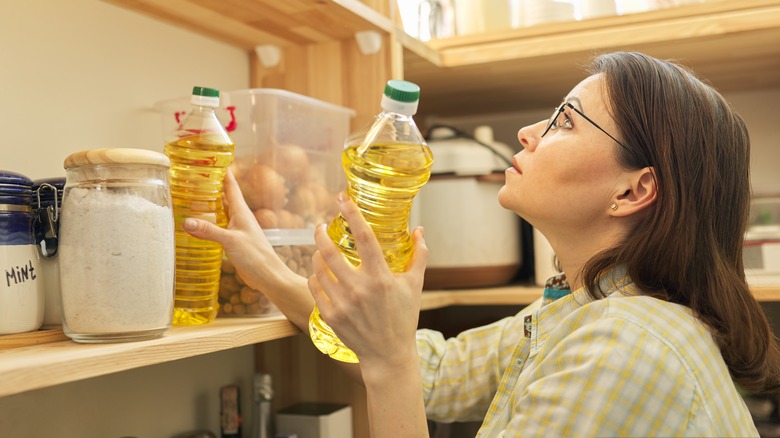What Is Algae Oil And How Do You Cook With It?
We may receive a commission on purchases made from links.
There's a new(ish) plant-based vegetable oil hitting the scene and it's made from algae. You heard that right. While the vibrant green plant we associate closely with pond scum or algae blooms may sound unappetizing, algae cooking oil is far removed from its plant parent. For starters, it is not green (surprisingly) and the flavor is very neutral. In fact, its lack of flavor is a selling point for one popular chef-backed brand of algae oil.
With plenty of vegetable oils like canola, avocado, olive, and sunflower on the market already, you may be wondering if there is any need for another option. The few companies that produce algae oil tout that it is a much more sustainable oil and the fatty acid profile is better for you than other popular oils. Plus, it has a very high smoke point and is almost flavorless, so algae oil may be more versatile than either olive oil or canola oil.
If you're feeling curious about this sleek new cooking oil, this guide is for you. You'll learn more about how algae oil is made, what it tastes like, as well as potential applications for using it in your own kitchen.
What is algae oil?
As you can probably guess from the name, algae oil is a newer plant-based oil (like olive oil or avocado oil) but this one is made from algae. When it comes to eating algae, you may already be familiar with macroalgae like kelp or seaweed. Those are different from microalgae — microscopic, single-cell organisms grown to produce algae oil. The microalgae grown for cooking oil are a specific species of algae that are efficient at producing a lot of oil that is rich in omega-9 fatty acids (otherwise known as monounsaturated fats). Some species of microalgae are also bred to produce omega-3 fats and typically used for supplements. Since omega-3s are not stable for high heat cooking, this type of algae isn't used for the cooking oil.
Even though it is made with such a vibrant colored substance, algae oil is surprisingly very light in color — similar to canola oil. In addition, this alternative cooking oil has a very neutral flavor, making it a good substitute for other neutral flavored oils. (Although, you will be dishing out more cash, since the cost for algae oil is two or three times higher than most popular vegetable oils.)
How is algae oil made?
While most of us are familiar with the algae in fresh and seawater, the algae used for the cooking oil is slightly modified. A company called Solazyme was one of the first to produce culinary algae oil after it tweaked the DNA to create a "super" algae that acts more like a yeast. It gathers energy from sugar, rather than the sun. This DNA swap also means that this algae can be grown quickly in large fermentation tanks. This type of algae is bred to be efficient at converting that sugar into oil. Once the algae is dried out, oil is cold pressed out of it, not dissimilar to pressing oil out of olives.
One of the selling points for algae oil over other vegetable oils is its sustainability. By some counts, more than 2.66 million acres of land across the U.S. is planted with canola, while 87.1 million acres are under soybean cultivation. All of which require machines to manage and lots of water. However, the unique algae fermentation process means that the algae oil isn't dependent on large fields or even limited to growing seasons like olives or sunflowers.
The one caveat to the sustainability of algae oil is that it is dependent on some source of sugar (in most cases it's sugarcane) to feed these fermentation tanks of algae. Regardless, third party sustainability studies presented by companies like Algae Cooking Club find algae oil to produce less carbon dioxide and utilize less water and land.
Algae oil vs olive oil
Overcoming the popularity of olive oil is going to be an uphill battle for algae oil. Olive oil is beloved not only for the health benefits, but the distinctive fruity or floral flavor it can add to a range of dishes from roasted vegetables to salad dressings. A staple of the Mediterranean diet, olive oil is rich in monounsaturated fats (mainly oleic acid) and antioxidants — both of these qualities make it a boon for heart health.
Algae oil, as a newcomer to the cooking scene, doesn't have years of research to say whether it has just as many health benefits. However, it does have higher levels of heart-healthy monounsaturated fats than olive oil. The Algae Cooking Club company notes its algae oil is 93 percent oleic acid — an average extra virgin olive oil contains around 65 percent oleic acid.
One of the selling points for algae oil over olive oil is the difference in smoke points. Some algae oils can have impressive smoke points up to 535 degrees Fahrenheit. That's a full 100 degrees higher than the highest smoke point of many olive oils, like EVOO, which ranges from 350 to 410 degrees Fahrenheit.) Smoke point is important if you're looking to reduce the amount of free radicals in your food, or just improve the taste of your dishes.
Another difference between the two oils is the viscosity. When making a vinaigrette, most of us reach for a flavorful but unrefined olive oil; algae oil consistency means it can emulsifying well, and unlike olive oil, won't potentially impart bitter flavors.
What does algae oil taste like?
If the words algae oil have invoked a flavor profile that is grassy, earthy or maybe even fishy, you'll be surprised. Algae oil has a surprisingly neutral flavor. According to the Algae Cooking Club, algae oil is a "light, slightly buttery neutral oil that elevates and enhances what you're cooking." This same brand is backed by chef Daniel Humm, owner of three Michelin star Eleven Madison Park. He's embraced the oil for both its lower climate impact as well as its neutral flavor profile.
Since it has so little flavor, you'll want to use algae oil for cooking compared to finishing. (Save the finishing for olive oil.) It's great for dishes where you want to trigger high enough temperature for the Maillard reaction, but you also want to make sure that the flavor of the oil itself doesn't come through. The lack of flavor also is why algae oil is often used for pan frying.
Speaking of frying, algae oil has a much higher oxidative stability than other oils which means you might be able to reuse the same batch of oil more times when frying. One algae oil brand, Spotlight Foods, has done an in-house fry study that compares different frying oils for oxidative stability and taste. Algae oil held up better after multiple batches of fries versus rice bran oil and canola oil. That said, outside research suggests that oxidative stability isn't inherent; it can depend on the health of microalgae and the methods used to process and purify the oil.
How to cook with algae oil
Algae oil has a high smoke point (as high as 535 degrees Fahrenheit) and can be used for a variety of culinary applications where a neutral oil would be the best choice. With such a high smoke point, algae oil makes a great alternative to canola oil or sunflower oil for frying. However, with the cost of algae oil being more than double other vegetable oils, it may be best to reserve it for shallow frying versus deep frying.
It's also best to use algae oil when cooking dishes where the delicate flavor of the ingredients should be prioritized. A neutral flavor allows other elements in dressings to shine — especially things like delicate herbs or citrus. For example, you may reach for algae oil for grilling a tender white fleshed fish, or frying squash blossoms. It is also a great choice for something like homemade mayonnaise, where you are aiming for a more neutral aspect. The oil can serve a function in the dish, rather than a certain flavor. Along with mayo, the thin consistency of algae oil can be a flex for vinaigrettes.
The potential for algae oil isn't limited to savory dishes either. The neutral flavor works well in baked goods like quick breads, cakes, cupcakes, and more. As a plant-based option with the traits of animal-based products, algae oil can mimic the fluff and moisture that This is especially true when the baked goods have a plainer flavor, like a simple vanilla cake.
Where to buy algae oil
The demand for algae oil is still small, so it's not exactly easy to find a bottle at your local grocery. For now, you can sometimes pick up a bottle from specialty stores like Erehwon where it will share a space with other shelf stable oil options. In addition to ordering algae oil from Amazon, you can also order it online through Thrive Market which carries one of the more popular brands: Algae Cooking Club. A 16-ounce bottle of algae oil usually costs around over 20 dollars, which is more expensive than similar other vegetable oils like canola or sunflower oil.
One thing to remember when shopping for algae oil is to make sure that the product is made for cooking. The algae oil you use to shallow fry a fish is much different than the other type of algae oil that is sold as an omega-3 supplement. While these two very different products aren't likely to be on the same shelf in the grocery store, it's worth keeping in mind when shopping online where a search for algae oil often brings up both options.
Nutritional information about algae oil
One of the selling points mentioned by algae oil producers is that the fat make up of algae oil is superior to other oils on the market. For example, when compared to olive oil (commonly associated with many health benefits) you'll see that both oils provide 120 calories per tablespoon and the same amount of total fat tallying 14 grams. However, if you look more closely at the type of fat — you'll find they differ.
Algae oil is high in omega-9 fatty acids, such as monounsaturated fat that is associated with all kinds of nutritional benefits like lowering inflammation. In addition, it has 1½ fewer grams of saturated fat compared to olive oil; and saturated fat is one type of fat that the American Heart Association recommends that we limiting in diets. However, unless you are using a lot of oil on a day-to-day basis, there may not be that much added benefit to making the switch from olive to algae oil.
How to store algae oil
Algae oil isn't cheap so you'll want to make sure you properly store your oil to optimize the longevity in your pantry. The same rules that apply to storing other vegetable oils so that they don't go bad can also be used for storing algae oil. Some brands of algae oil have shelf lives up to two years if unopened; most vegetable oils, like avocado oil, have a similar expiration date. When it comes to storing oils like olive oil or algae oil, it pays to pay attention to air, light, and temperature.
For starters, make sure that you are properly closing the bottle on your algae oil after use. When oil is exposed to air, the oxygen present starts to oxidize the unsaturated fats in the oil causing it to go rancid faster. Exposure to UV light speeds up the process of oxidation, so storing in dark bottles and behind a cupboard door will prolong the shelf life of your algae oil.
Additionally, algae cooking oil has a higher oxidative stability than other oils which means it can be stored longer before the oxidation process causes it to go rancid. (A definite perk for an oil that is so expensive.) Finally, temperature will also affect the lifespan of your oil so store in a cabinet away from the heat of the oven or stovetop.








